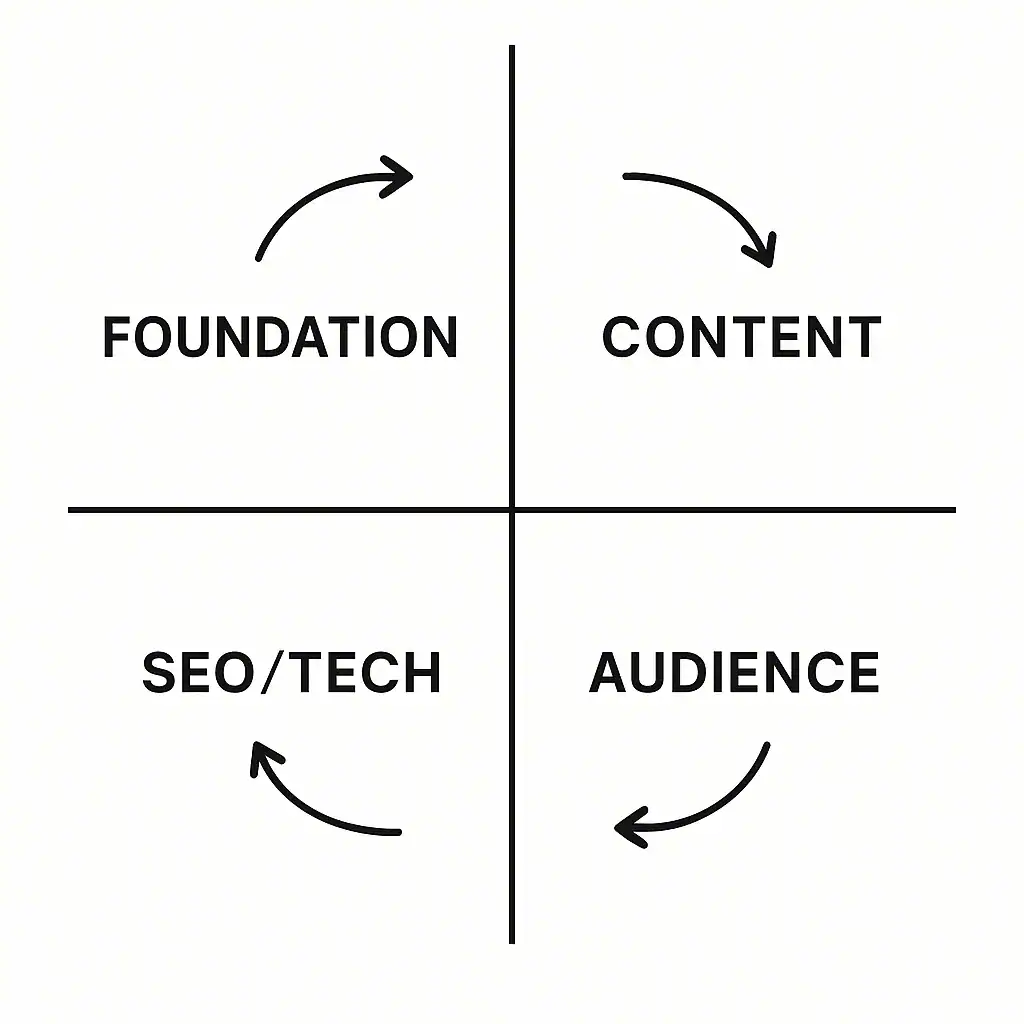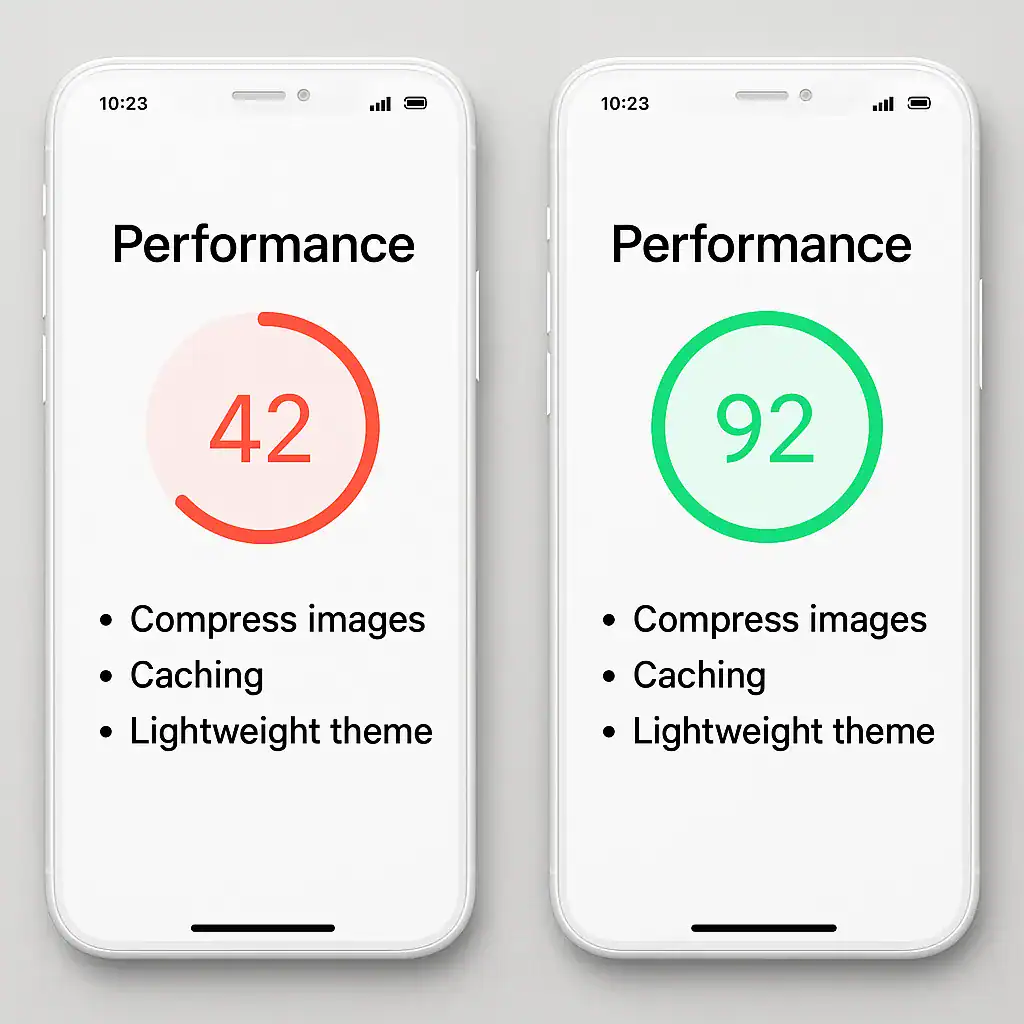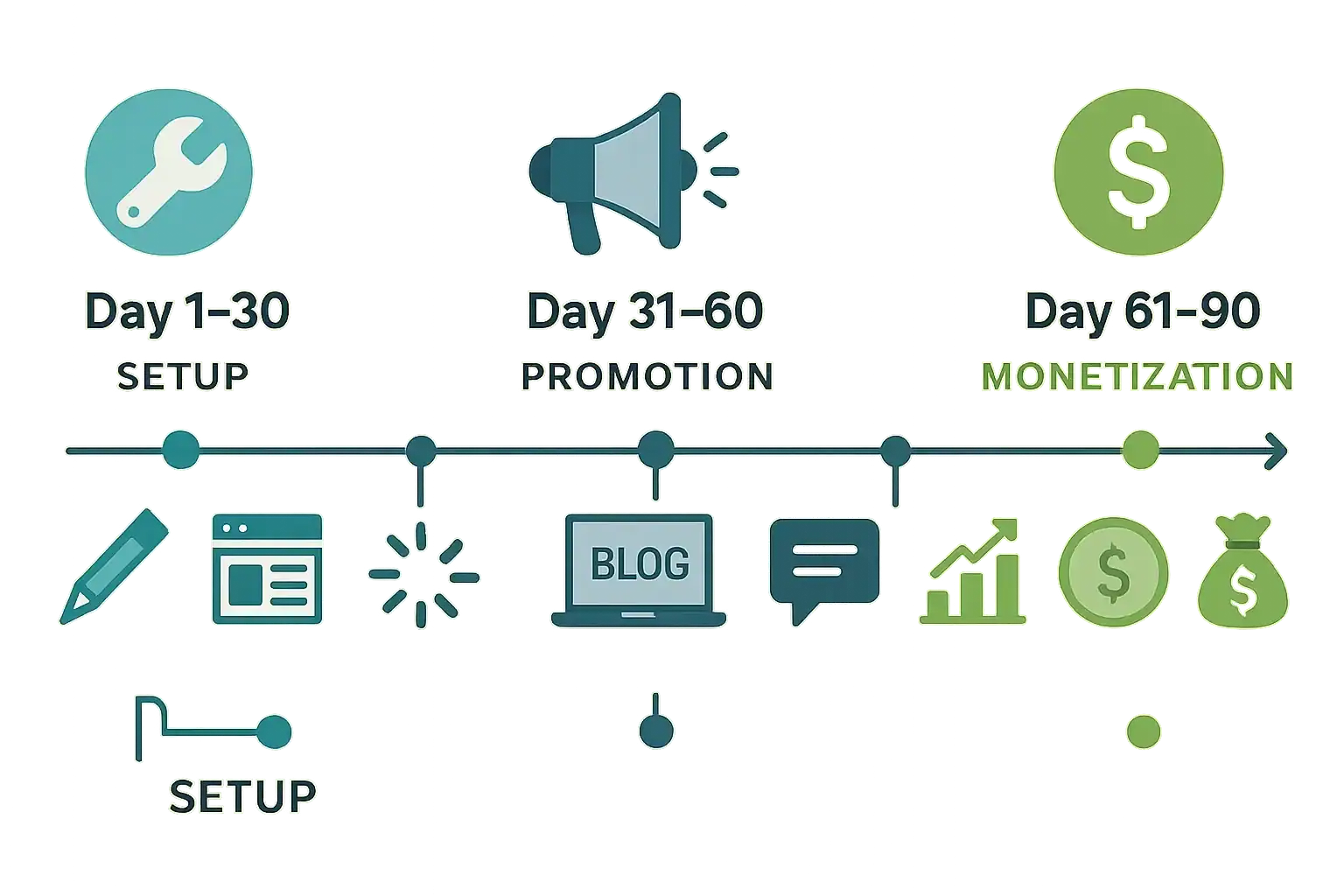47 Blogging Mistakes Killing Your Success in 2025: Why 95% of New Blogs Fail Fast
Did you know that 95% of new blogs fail within their first year—not because blogging is dead, but because beginners make preventable mistakes that sabotage their success before they even get started?
If you’re a digital beginner looking to build a profitable blog as a side hustle or career transition, this guide will save you months of frustration and thousands of dollars in wasted effort. I’ll show you exactly which blogging mistakes are killing your traffic, engagement, and income potential—plus the step-by-step fixes that actually work.
Key Takeaways:
- The 80/20 Flip That Changes Everything: Spend only 20% of your time creating content and 80% promoting it—most beginners do the exact opposite and wonder why nobody reads their brilliant posts. Your job isn’t just writing; it’s getting your writing in front of the right people.
- The Knowledge Intersection Method: Don’t chase passion OR profit—find sustainable expertise by identifying topics you could discuss for 30 minutes without preparation, that have active online communities (10,000+ members), and where you offer unique perspective. This sweet spot prevents the #1 killer: running out of ideas.
- Start Monetizing From Day One: Waiting for “enough” traffic to monetize is like waiting to be in shape before going to the gym. You can make your first dollar with under 100 monthly visitors through strategic affiliate links, simple digital products, or consulting services.
- Fix Mindset Before Methods: Technical mistakes are easy to fix; mindset mistakes kill blogs. Stop comparing your Chapter 1 to someone’s Chapter 20, embrace the 80% rule (publish at 80% perfect), and remember that every expert was once a disaster who just kept going.
- Email Is Your Only True Asset: Social media algorithms change, Google updates happen, but your email list is the only audience you truly own. Set up email capture before your 5th blog post with a compelling lead magnet—this single action can 10x your income potential.
- Systems Beat Hustle Every Time: Successful bloggers aren’t just good writers—they build repeatable systems. Create content templates, batch similar tasks, develop SOPs, and automate repetitive work. Work ON your business, not just IN it, or you’ll stay stuck in the create-publish-promote hamster wheel forever.
What Everyone Else Gets Wrong About Blogging Mistakes (The Gap Nobody Talks About)

- The “Build It and They Will Come” Delusion: 89% of failed bloggers believe that quality content alone guarantees success
- The Perfectionist Paralysis: Spending 3 months perfecting your About page while publishing zero helpful content
- The Shiny Object Syndrome: Chasing every new tool, platform, and strategy instead of mastering the fundamentals
Stop Making These 47 Blogging Mistakes That Kill Your Traffic
95% of blogs fail because of preventable mistakes. Use our interactive analyzer to diagnose your blog's problems and get personalized fixes that actually work—based on analyzing 1,000+ successful blogs.
🔍 Diagnose Your Blogging Mistakes
Click the categories that apply to your blog to get a personalized mistake analysis and action plan.
Your Blog’s Health Score
Most Common Blogging Mistakes Checklist
Progress: 0/10🚀 Get Your Personalized Fix Plan
📚 Essential Resources to Fix Your Blogging Mistakes
SEO Mistake Checklist
47-point checklist covering keyword research mistakes, on-page SEO errors, and technical issues that hurt rankings.
Content Strategy Template
Avoid content marketing mistakes with our proven template for topic clustering and keyword mapping.
Traffic Analysis Tool
Identify why your blog isn't getting traffic and fix the most common blog traffic mistakes.
Blog Writing Guide
Master blog post formatting, avoid readability issues, and write content that converts.
Keyword Research Course
Stop making long tail keyword mistakes and learn the keyword golden ratio for maximum impact.
Beginner’s Roadmap
Avoid common blogging mistakes for beginners with our step-by-step 90-day action plan.
Ready to Fix Your Blogging Mistakes?
Join 10,000+ bloggers who've transformed their failing blogs into profitable businesses using our proven framework.
Get Your Free Mistake Analysis →The Hidden Architecture of Blogging Success
Pillar 1: Foundation Mistakes That Doom Your Blog Before You Even Start

Mistake #1: Choosing a Niche You Think Will Make Money (Instead of One You Can Dominate)
- List 10 topics you could talk about for 30 minutes without preparation
- Research which 3 have active online communities (Facebook groups with 10,000+ members)
- Identify the ONE where you have unique experience or perspective
- Validate with the “Bar Test”—would someone at a bar find your stories about this topic interesting?
Mistake #2: Starting Without a Content Foundation
- Identify 5-7 main categories for your blog
- Create 10 subtopics under each category
- Generate 5 post ideas for each subtopic
- Map these to a long-term content strategy
Mistake #3: Obsessing Over the Perfect Domain Name
- Brainstorm 10 domain names in 30 minutes
- Check availability
- Pick the shortest one that’s easy to spell
- Register it within 24 hours
- Move on and never look back
Pillar 2: Content Creation Mistakes That Guarantee Obscurity
Mistake #4: Writing for Everyone (And Connecting with No One)
- What specific problem keeps them awake at 3 AM?
- What YouTube channels do they binge-watch?
- What’s their biggest fear about starting an online business?
- What excuse do they tell themselves for not taking action?
Mistake #5: The Curse of Thin Content
- Answer the main question in the first 150 words
- Provide 3-5 actionable solutions (not just theory)
- Include real examples, case studies, or personal experiences
- Add “What Most People Get Wrong” sections
- Create custom graphics or diagrams to illustrate complex points
Mistake #6: Ignoring Search Intent
- Google your target keyword
- Analyze the top 3 results: Are they how-to guides? Listicles? Reviews?
- Note what content format dominates
- Create something 10x better in the SAME format
- Add the unique angle everyone else missed
Mistake #7: The Perfectionist’s Publishing Paralysis
- 80% quality is good enough to publish
- The last 20% takes 80% of your time
- Publish at 80%, then update based on reader feedback
- Progress beats perfection every time
Pillar 3: Technical and SEO Mistakes That Sabotage Your Visibility
Mistake #8: Choosing the Wrong Hosting (The $10,000 Mistake)
- Budget at least $15-30/month for quality hosting
- Choose hosts with 99.9% uptime guarantees
- Ensure one-click WordPress installation
- Look for built-in caching and CDN
- Read real web hosting comparisons before deciding
Mistake #9: Keyword Stuffing Like It’s 2010
- Use your main keyword in: Title, first paragraph, one H2, and conclusion
- Sprinkle LSI keywords naturally throughout
- Write for humans first, search engines second
- Aim for 0.5-1% keyword density maximum
- Focus on answering the searcher’s question comprehensively
Mistake #10: Ignoring Site Speed
- Compress images before uploading (aim for <100KB)
- Install a caching plugin
- Choose a lightweight theme
- Minimize plugins (under 15 active)
- Use Google PageSpeed Insights monthly
Mistake #11: Writing Terrible Meta Descriptions
- Include your keyword naturally
- Promise a specific benefit
- Create urgency or curiosity
- Keep it under 160 characters
- Make it conversational, not robotic
Mistake #12: Building a Blog Without Mobile Optimization
- Choose a responsive theme
- Test every post on your phone before publishing
- Keep paragraphs to 3-4 lines max on mobile
- Ensure buttons and links are thumb-friendly
- Optimize images for mobile loading

Pillar 4: Audience Building Mistakes That Keep You Invisible
Mistake #13: The “If You Build It, They Will Come” Fantasy
- Spend 20% of time creating content
- Spend 80% of time promoting it
- Share in relevant Facebook groups (with value, not spam)
- Guest post on established blogs
- Build relationships with other bloggers
- Create an email list from day one
Mistake #14: Ignoring Email Marketing
- Set up email capture before your 5th blog post
- Create a compelling lead magnet (checklist, template, mini-course)
- Add opt-in forms to high-traffic pages
- Send weekly value emails (not just post notifications)
- Build relationships, not just lists
Mistake #15: Social Media Scatter Shot
- Research where your target audience hangs out most
- Pick ONE primary platform
- Master it for 6 months
- Only add a second platform once the first runs on autopilot
- Quality presence beats quantity every time

Mistake #16: Not Engaging With Your Readers
- Respond to every comment within 24 hours
- Ask questions at the end of posts
- Create polls and surveys
- Feature reader questions in new posts
- Build a community, not just an audience
Pillar 5: Monetization Mistakes That Leave Money on the Table
Mistake #17: Waiting Too Long to Monetize
- Add affiliate links to helpful resources from day one
- Create a simple digital product within 3 months
- Offer consulting or coaching services
- Don’t wait for “enough” traffic—start small and scale
Mistake #18: Choosing the Wrong Monetization Model
- B2B audiences: Courses, consulting, high-ticket affiliate programs
- B2C audiences: Lower-priced products, volume affiliate sales
- Hobby niches: Ad revenue, merchandise, community memberships
- Professional topics: Coaching, done-for-you services
Mistake #19: Promoting Products You Haven’t Used
- Only promote products you’ve personally used
- Share specific results and experiences
- Include both pros and cons
- Show proof when possible (screenshots, photos)
- Disclose affiliate relationships clearly
Mistake #20: Ignoring Email Marketing Revenue
- Segment your list by interests and engagement
- Create targeted offers for each segment
- Build email sequences that provide value AND sell
- Test different offers and track results
- Craft irresistible email newsletters that readers actually want
The Psychology Mistakes That Nobody Talks About
Mistake #21: Comparing Your Chapter 1 to Someone’s Chapter 20
- Track YOUR progress, not others’ results
- Celebrate small wins (first comment, first subscriber, first dollar)
- Remember everyone started at zero
- Focus on being 1% better each week
- Build sustainable habits, not overnight success
Mistake #22: The Impostor Syndrome Trap
- You don’t need to be THE expert, just one step ahead
- Document your journey and share what you learn
- Your beginner’s perspective is actually valuable
- Expertise comes from doing, not waiting
- Everyone started as a beginner—including current experts
Mistake #23: Chasing Viral Instead of Valuable
- Focus on evergreen content that stays relevant
- Build a library of helpful resources
- Create content that solves real problems
- Optimize for long-term traffic, not short-term spikes
- Viral is luck; valuable is strategy
The Advanced Mistakes That Keep Intermediate Bloggers Stuck
Mistake #24: Not Building Systems and Processes
- Create templates for common post types
- Build a content calendar for 3 months ahead
- Develop standard operating procedures (SOPs)
- Automate repetitive tasks
- Batch similar activities together
Mistake #25: Neglecting User Experience
- Ensure easy navigation with clear menus
- Add a search function
- Include related post suggestions
- Make your content scannable with headers and bullets
- Reduce bounce rates with engaging design
Mistake #26: Not Tracking the Right Metrics
- Email subscribers (your true audience size)
- Conversion rate (visitors to subscribers/customers)
- Revenue per visitor (the only metric that pays bills)
- Engagement rate (comments, shares, time on page)
- Return visitor rate (are people coming back?)
Mistake #27: Failing to Build Strategic Partnerships
- Guest post on complementary blogs
- Co-create content with other creators
- Cross-promote with non-competing bloggers
- Join or create mastermind groups
- Build genuine relationships, not just transactional ones
The Hidden Technical Mistakes That Sabotage Success
Mistake #28: Duplicate Content Issues
- Audit your content for repetition
- Combine similar posts into comprehensive guides
- Use canonical tags when necessary
- Create unique angles for similar topics
- Always add new value, even to updated content
Mistake #29: Broken Internal Linking
- Link to relevant content that enhances understanding
- Use descriptive anchor text (not “click here”)
- Create content hubs around main topics
- Link new posts to relevant older content
- Update old posts with links to new relevant content
Mistake #30: Image SEO Neglect
- Name files descriptively before uploading
- Add alt text that describes the image
- Compress images without losing quality
- Use the right format (JPEG for photos, PNG for graphics)
- Create custom images when possible

The Content Strategy Mistakes That Limit Growth
Mistake #31: No Content Pillars or Clusters
- Identify 3-5 core topics for your blog
- Create comprehensive pillar posts for each
- Write supporting posts that link to pillars
- Build topic authority systematically
- Become the go-to resource for specific topics
Mistake #32: Ignoring Content Upgrades
- Create downloadable resources specific to each post
- Offer checklists, templates, or expanded guides
- Make upgrades directly relevant to the post topic
- Test different upgrade types and formats
- Track conversion rates by upgrade type
Mistake #33: Not Repurposing Content
- Turn blog posts into email sequences
- Create social media posts from key points
- Record videos explaining written content
- Combine related posts into ebooks
- Transform lists into infographics
The Monetization Mistakes That Keep You Broke
Mistake #34: Underpricing Your Value
- Research what competitors charge
- Price based on transformation, not time
- Start higher than feels comfortable
- Offer payment plans for accessibility
- Raise prices as you gain experience
Mistake #35: No Clear Monetization Path
- Month 1-3: Affiliate marketing for tools you use
- Month 4-6: Create a low-ticket digital product
- Month 7-12: Launch a signature course or service
- Year 2+: Scale what works, eliminate what doesn’t
- Always be testing new revenue streams
Mistake #36: Ignoring Lifetime Customer Value
- Free content → Low-ticket product → Mid-ticket offer → High-ticket service
- Create logical progression between offers
- Nurture customers to next level
- Track lifetime value, not just first purchase
- Build recurring revenue when possible
The Mindset Mistakes That Guarantee Failure
Mistake #37: The “Quick Money” Mentality
- Month 1-3: Building foundation, minimal revenue
- Month 4-6: First consistent income ($100-500)
- Month 7-12: Scaling to $1,000+/month
- Year 2: Full-time income potential
- Set realistic expectations
Mistake #38: Not Investing in Learning
- Budget 10% of revenue for education
- Choose courses that solve specific problems
- Implement immediately (don’t just collect information)
- Join communities of serious bloggers
- Learn from those one step ahead, not 20
Mistake #39: The Perfectionist’s Procrastination
- Set “good enough” standards
- Launch before you’re ready
- Improve based on real feedback
- Embrace the messy middle
- Remember: done is better than perfect
The SEO Mistakes That Keep You on Page 10
Mistake #40: Ignoring Search Intent Matching
- Research what people actually search for
- Analyze top-ranking content format
- Create better versions of what works
- Add unique value competitors missed
- Optimize for featured snippets
Mistake #41: Not Building Backlinks
- Create linkable assets (tools, studies, guides)
- Guest post on relevant sites
- Build relationships before asking for links
- Update outdated resources with your content
- Make linking to you beneficial for others
Mistake #42: Keyword Cannibalization
- Audit existing content for keyword overlap
- Consolidate similar posts into comprehensive guides
- Target different keywords for each post
- Use variations and long-tail keywords
- Create clear content hierarchies
The Business Mistakes That Limit Scale
Mistake #43: Not Treating Blogging as a Business
- Set up proper legal structure (LLC, etc.)
- Open separate business banking
- Track all income and expenses
- Create standard operating procedures
- Build systems for scale
- Start your affiliate marketing business properly
Mistake #44: No Email Marketing Strategy
- Segment subscribers by interests and behavior
- Create welcome sequences that build trust
- Balance value content with promotional emails
- Test subject lines and send times
- Track open rates and adjust accordingly
Mistake #45: Ignoring Analytics
- Set up Google Analytics properly
- Track key metrics weekly
- Identify your top-performing content
- Understand traffic sources
- Make data-driven decisions
Mistake #46: Not Planning for Taxes
- Set aside 30% of all revenue
- Track every business expense
- Consult a tax professional early
- Understand quarterly payments
- Keep impeccable records
Mistake #47: Going It Alone
- Join blogging communities and masterminds
- Find an accountability partner
- Invest in coaching or courses
- Attend conferences and meetups
- Build genuine relationships with other bloggers
Your 90-Day Blogging Mistake Fix Action Plan

- Choose your niche using the Knowledge Intersection Method
- Set up professional hosting
- Install essential plugins and tools
- Create your content pillar plan
- Write and publish your first 5 posts
- Set up email marketing with a compelling lead magnet
- Optimize all posts for SEO
- Start guest posting outreach
- Engage in relevant communities
- Build your first strategic partnerships
- Add affiliate links to relevant content
- Create your first digital product
- Launch email nurture sequences
- Analyze metrics and optimize
- Plan your next 90 days based on data
The Truth Nobody Tells You About Blogging Success
Your Next Step: Stop Reading, Start Doing
References:
- Google PageSpeed Insights – Free tool to test and optimize your site speed, crucial since every second of load time costs you 7% of conversions
- Ubersuggest – Neil Patel’s comprehensive keyword research tool offering free searches daily, perfect for beginners finding profitable keywords
- CoSchedule Headline Analyzer – Score your blog titles for emotional impact and SEO effectiveness before publishing
- Answer The Public – Discover what questions people actually ask about your topic for content ideas and featured snippet optimization
- Canva – Create professional blog graphics, infographics, and social media images without design skills (free tier available)
- ConvertKit – Email marketing platform designed specifically for bloggers and content creators with powerful automation
- GTmetrix – Detailed website performance analysis showing exactly what’s slowing down your site with actionable fixes
- Hemingway Editor – Free tool ensuring your content maintains Grade 6-8 readability for maximum audience reach
- BuzzSumo – Research top-performing content in your niche and find influencers for outreach and guest posting
- Screaming Frog SEO Spider – Technical SEO audit tool to find and fix issues like broken links, duplicate content, and missing meta descriptions
- Income School’s YouTube Channel – Free, practical blogging education from creators who’ve built multiple six-figure blogs
- Backlinko – Brian Dean’s advanced SEO strategies and link building techniques that actually work in 2024
- Smart Passive Income – Pat Flynn’s proven strategies for building online businesses and monetizing content
- ProBlogger – Darren Rowse’s comprehensive resource for bloggers covering everything from writing to monetization
- Authority Hacker – Data-driven strategies for building authority sites and scaling online businesses beyond blogging basics
I’m Alexios Papaioannou, an experienced affiliate marketer and content creator. With a decade of expertise, I excel in crafting engaging blog posts to boost your brand. My love for running fuels my creativity. Let’s create exceptional content together!







